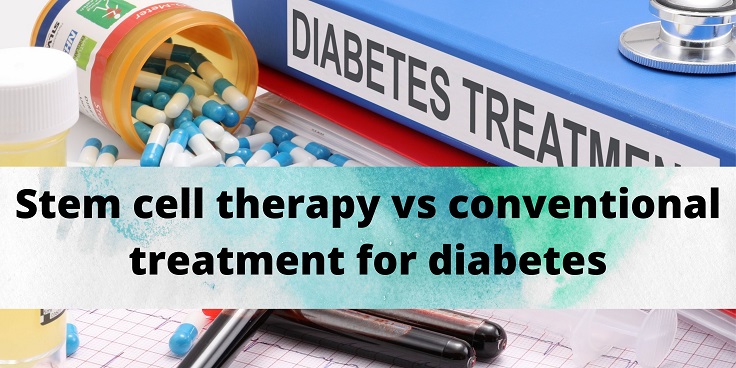Today we are going to know the difference between conventional treatment and stem cell therapy for diabetes.
Did you know about 422 million people worldwide have diabetes and people are migrating slowly and continuously from one stage to the next?
It always starts with the pre-diabetic stage and reaches to end-stage provided people are alive to see the end-stage. Many people develop other complexities due to diabetes and are not able to see the end-stage of the disease.
Diabetes is a degenerative pancreatic disease that causes high blood sugar levels and glucose intolerance.
The degree of hyperglycemia (High blood glucose) is used to determine the severity of diabetes. Chronic hyperglycemia caused by uncontrolled diabetes can lead to serious health problems such as heart disease, long-term damage to the eyes, kidney failure, Neuro diseases, foot ulcers, infections, and gangrene.
To control diabetes there are many treatment methodologies that work at different stages of diseases. These treatment methodologies include exercises, weight control, ayurvedic medicine and medical nutrition therapy, oral glucose-lowering drugs, and injections of insulin.
One thing that is common these methods are not curative treatments and are used to manage diabetes.
The curative treatment might be a pancreatic transplant whereby the pancreas, an organ responsible for insulin production is transplanted. However, doctors recommend pancreatic transplants only in end stages diseases. Moreover, a pancreatic transplant is complex and very costly surgery and has a dependency on the donor.
With the advancement of stem cell research, researchers are able to come up with a stem cell therapy to treat diabetes in a curative way, whereby your dependency on medication and/or insulin will be rolled back.
If you want to understand stem cell therapy for diabetes in detail, Please visit stem cell therapy for diabetes.
Let’s now understand the pros and cons of conventional treatment Vs stem cell therapy for diabetes.
Conventional treatment vs Stem cell therapy for diabetes
| Conventional treatment | Stem cell therapy | |
| Curative Treatment or diseases management | Insulin and medicine are used to control the amount of glucose in your blood. It is not a cure treatment it is used to control diabetes. Slowly and gradually, people on medication move to insulin dependency. | Stem cell therapy for diabetes is a curative treatment for diabetes. Stem cell therapy is designed to rejuvenate the pancreas which helps the body to produce insulin naturally. If given in the early stages, the dependency on medication and insulin can be reversed. |
| Dosage | Patients who are on medication will observe a slow and gradual increase in dosages of medication. At a certain point in time when medication is not able to manage the sugar levels, external insulin support will be required. Patients who are on insulin support need to take insulin daily before consumption of food. The doses of indulin also increase with time. | Stem cell therapy for diabetes reduces the dosages of medication and insulin as the body starts producing insulin naturally. If given in the early stages, the dependency on medication and insulin can be reversed. Stem cell experts based on your current level of diseases and other comorbidities will design a customized protocol and decide, the number of stem cells, source of stem cell, and cycles of stem cell therapy. |
| Side-effects | Some of the common side-effects that medication and insulin can develop are upset stomach, skin rash or itching, weight gain, tiredness, and if not taken properly can even low blood sugar extremely. | No Side-effects as stem cells are our own cells that are used to treat the disease and regenerate the pancreas to regain proper functioning. |
| Convenience | Medication that can be easily consumed. Repeated and multiple small pricks for insulin injection for the patients who are currently on insulin. The strict discipline to take medication or insulin on time as prescribed. | Stem cell therapy is performed by stem cell specialists which requires a special laboratory to process the stem cells and the medical setup to extract and inject the stem cell. The therapy is going to be injection-based and needs to be performed in a hospital. |
| Longevity | Short-term effects. Need to take insulin and medication daily as prescribed and the medication and effectiveness are for a few hours or a day. The patient needs to take the medication and insulin lifetime. | Long-term effect and possibly curative treatment which removes the dependency on insulin and medication if taken in the early stage. If taken in the later stages it reduces your dependency on medication and insulin. In a few cases, a repeat cycle may also be required. |
| End-stage | Pancreas transplant is the only treatment in the end-stage. There is a high probability that the kidney might also be damaged due to diabetes so in some cases both kidney and pancreas transplants would be required. The availability of the donor and the waiting period can be a big reason for worry. | Stem cells are the basic building block of our body. The main functionality of stem cells is to regenerate the damaged cells and make copies of their own cells to repair the damaged cells. Your own body is healing you and deferring the need for a transplant. |
Conclusion
Traditional therapeutic methods, such as daily medication or injections of exogenous insulin, are the most common treatment for diabetes, but their use is frequently associated with failure of glucose metabolism control, which leads to hyperglycemia episodes.
Stem cell therapy for diabetes is a promising strategy for avoiding the problems associated with daily insulin injections. To maintain glucose homeostasis, this therapeutic method is expected to produce, store, and supply insulin. To completely cure diabetes, cell-based therapies aim to produce functional insulin-secreting cells.
Exercise and healthy foods will complement the longevity of the treatment.
You may also like to read why stem cell is considered a permanent solution for diabetes.
If you want to consult a stem cell therapy specialist and have questions please feel free to fill the contact us.
FAQ
What is the current status of Stem cell therapy from the regulatory framework?
The stem cell-based therapy is in the research phase and not yet formally approved by ICMR. However, the application of stem cells, popularly known as bone marrow transplants, in blood-related disorders is approved by ICMR.




